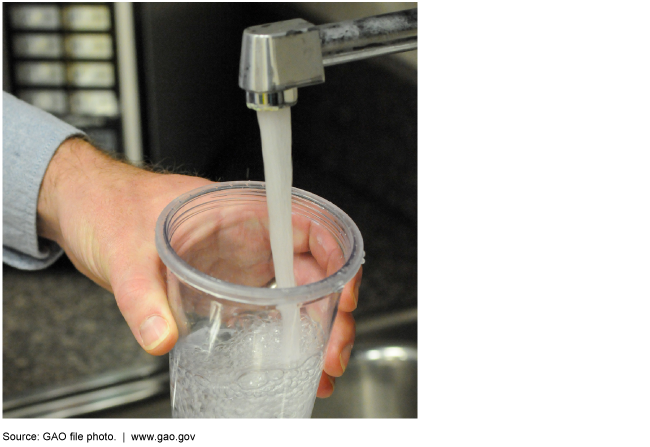Alternative Drinking Water Systems: Use by Very Small Communities, Related Cost Savings, and Technical Assistance Provided by EPA and USDA
Fast Facts
Small communities may lack the resources needed to maintain or replace drinking water systems. New or nonconventional approaches have the potential to do a better, more cost-effective job of providing drinking water.
We identified some alternative systems used by communities of 500 or fewer people, such as using a sand filtration process and devices that treat water as it enters a home. The costs of using such systems can vary widely.
EPA and USDA each have programs that provide technical assistance for systems serving 10,000 or fewer people. The agencies awarded $62.9 to $96 million annually through these programs in fiscal years 2016-2018.

A person filling a cup with tap water
Highlights
What GAO Found
GAO found limited information on the use of alternative drinking water systems serving communities of 500 or fewer people. Alternative drinking water systems are substitute systems (e.g., wells and well systems) or innovative systems featuring advanced methods identified by the Environmental Protection Agency (EPA), the U.S. Department of Agriculture (USDA), or others. Through review of EPA’s Safe Drinking Water Information System (SDWIS), a data system that contains limited information on treatment processes used by public water systems; a review of relevant studies, reports, and webpages; and interviews, GAO identified examples of alternative drinking water systems used in communities of 500 or fewer people. These included
- biosand filtration—a sand filtration process used to remove bacteria,
- low-pressure microfiltration or ultrafiltration membrane— a physical filtration process used to remove suspended particles and microorganisms,
- point-of-entry treatment—a device installed at the water entry point to treat all water as soon as it enters each home or building in a water system,
- point-of-use treatment— a device installed at a single water tap, such as a kitchen faucet, to treat water primarily used for drinking and cooking in each home or building (see figure), and
- ultraviolet disinfection—ultraviolet light emitting lamps used to inactivate microorganisms.
Point-of-Use Treatment: An Example of an Alternative Drinking Water System Used in Communities of 500 or Fewer People

GAO also found there is an unknown range of cost savings to communities of 500 or fewer people using alternative drinking water systems. Based on a review of EPA cost models for various alternative system types and according to interviews with EPA, USDA and other officials, the costs and cost savings are case-specific and may vary widely depending on a number of factors. For example, costs and cost savings can vary based on the distance of a community from a supplier for the transportation of goods or services or options of conventional systems that are available, such as hookup to a public water system.
Regarding technical assistance programs, EPA and USDA each administer two programs that provide drinking water technical assistance for systems serving 10,000 or fewer people. These agencies awarded a total of $62.9 million to $96 million annually in fiscal years 2016 through 2018 to support technical assistance activities under these programs. Technical assistance activities funded under the four programs included training on a wide range of topics from Safe Drinking Water Act rules, such as monitoring and sampling rules, to drinking water risk communication. The programs also provided on-site technical assistance to small communities with their drinking water systems, including assistance with operation and maintenance, such as leak detection and repair, and management and finance, such as development of policies and water rate structures.
Why GAO Did This Study
According to EPA, small communities face financial and other challenges that limit their ability to achieve and maintain system sustainability. New or nonconventional approaches have the potential to provide small communities with better or more cost-effective access to drinking water. According to estimates in SDWIS, nearly 4.6 million people depend on community water systems that serve 500 or fewer people and more than half of the nation's community water systems serve this population range. For the purposes of this report, these systems are referred to as “very small.”
Congress included a provision in statute for GAO to report on the use of innovative and alternative drinking water systems serving very small communities and on drinking water technical assistance programs operated by EPA and USDA. This report describes (1) what is known about the use of alternative drinking water systems serving 500 or fewer people; (2) what is known about the range of any cost savings to such communities using alternative drinking water systems; and (3) drinking water technical assistance programs administered by EPA and USDA. Among other things, GAO conducted a literature search, reviewed the SDWIS database, and reviewed reports and funding data for EPA and USDA drinking water technical assistance programs. GAO interviewed EPA and USDA officials, representatives from two national research centers for small drinking water systems, and others.
For more information, contact J. Alfredo Gómez at (202) 512-3841 or gomezj@gao.gov.
